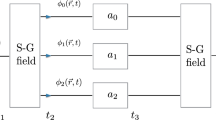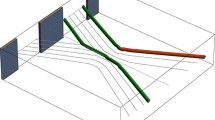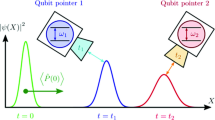Abstract
Hepp proposed to solve the measurement problemby taking as pointer observable one of the classicalobservables arising naturally in infinite quantumsystems. Here a time evolution is proposed whichfinishes the measurement in finite time. This timeevolution arises naturally as the limit of measurementinteractions of finite systems when the particle numbertends to infinity.
Similar content being viewed by others
REFERENCES
Araki, H. (1980). Progress of Theoretical Physics, 64, 719.
Bóna, P. (1973). Acta Physica Slovaca, 27, 101.
Bóna, P. (1988). Journal of Mathematical Physics, 29, 2223.
Breuer, T. Amann, A., and Landsman, N. P. (1993). Journal of Mathematical Physics, 34, 5441.
Bub, J. (1988). In PSA 1988, Vol. 2, Philosophy of Science Association, East Lansing, Michigan, Plenum Press, New York, pp. 134–144.
Bub, J. (1989). In Bell's Theorem, Quantum Theory, and Conceptions of the Universe, M. Kafatos, ed., Kluwer, Boston.
Frigiero, A. (1974). Annales de l'Institut Henri Poincaré A, 3, 259.
Hepp, K. (1972). Helvetica Physica Acta, 45, 237.
Hepp, K., and Lieb, E. H. (1973). Helvetica Physica Acta, 46, 573.
Kudaka, S., Matsumoto, S., and Kakazu, K. (1989). Progress of Theoretical Physics, 82, 665.
Landsman, N. P. (1991). International Journal of Modern Physics A, 6, 30.
Landsman, N. P. (1995)....
Machida, S., and Namiki, N. (1980). Progress of Theoretical Physics, 63, 1457, 1833.
Morchio, G. F., and Strocchi, F. (1987). Journal of Mathematical Physics, 28, 622.
Nakazato, H., and Pascazio, S. (1992). Physical Review A, 45, 4355.
Namiki, M., and Pascazio, S. (1991). Foundations of Physics Letters, 4, 203.
Narnhofer, H., and Thirring, W. (1990). Physical Review Letters, 64, 1863.
Robinson, D. (1990). In PSA 1990, Philosophy of Science Association, East Lansing, Michigan, Vol. 1, pp. 251–261.
Robinson, D. (1994). British Journal for the Philosophy of Science, 45, 79.
Unnerstall, T. (1990). Communication s in Mathematical Physics, 130, 237.
Von Neumann, J. (1932). Die mathematischen Grundlagen der Quantenmechanik, Springer, Berlin.
Von Neumann, J. (1938). Compositio Mathematica, 6, 1.
Wan, K. K. (1980). Canadian Journal of Physics, 58, 976.
Whitten-Wolfe, B., and Emch, G. G. (1976). Helvetica Physica Acta, 49, 45.
Rights and permissions
About this article
Cite this article
Breuer, T. How the Classical Pointer Moves. International Journal of Theoretical Physics 37, 235–240 (1998). https://doi.org/10.1023/A:1026606515783
Issue Date:
DOI: https://doi.org/10.1023/A:1026606515783




